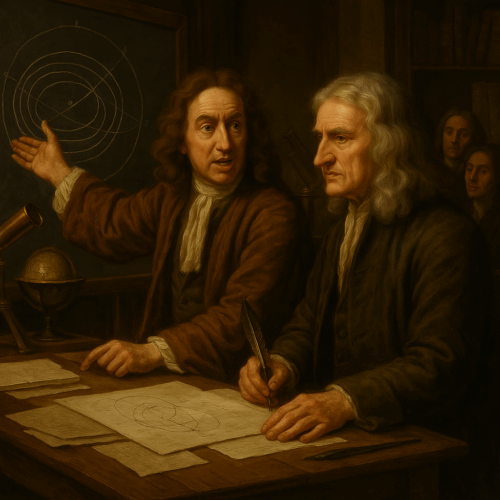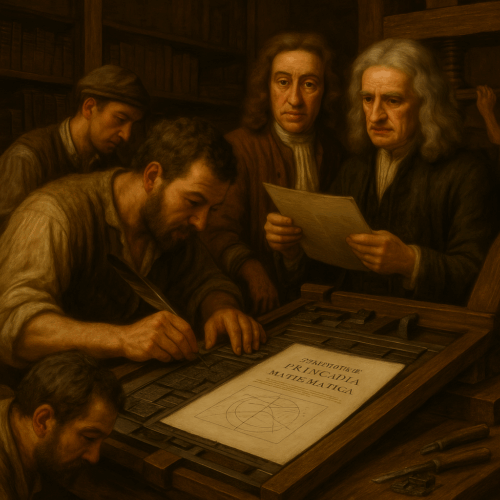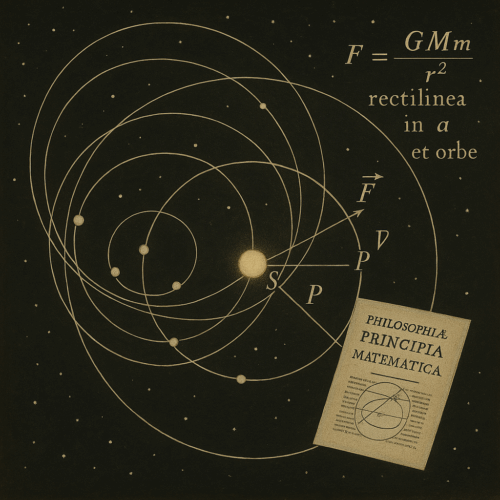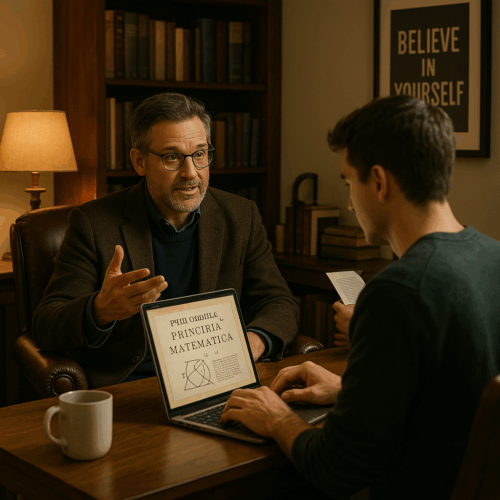Imagine the world on July 5, 1687. Across Europe, scholars plotted the stars by candlelight and debated cosmic mysteries in clubhouses. In a small London print shop, movable type clacked as a revolutionary manuscript emerged: Isaac Newton’s Philosophiæ Naturalis Principia Mathematica—an alchemy of observation and geometry that forged the laws of motion and universal gravitation into a single, elegant work. That day, science as we know it was born.

The publication of Principia was seismic. It unified Earth and sky, explained why apples fall and moons orbit, and provided a blueprint for rigorous inquiry that still guides us. Yet behind those polished theorems lay years of personal struggle, bursts of genius during plague lockdowns, and a pivotal friendship with Edmond Halley. More than a distant historical milestone, Newton’s journey offers a template for transforming any spark of an idea into a seismic shift in your life.
In this expanded exploration, we’ll dive deep into the context, creation, and impact of the Principia. We’ll trace Newton’s process, examine how his insights rippled across fields, and distill his methods into actionable strategies you can apply today. By the end, you’ll have a comprehensive plan—free of dry tables, rich in narrative and motivation—to launch your own “Principia” project. Let’s begin.
—
## I. The World Before Newton: A Cosmos in Puzzlement
In the mid-17th century, astronomy and physics were vibrant but fragmented. Observers like Tycho Brahe and Johannes Kepler had charted planetary paths with remarkable accuracy, yet the driving forces behind those motions remained mysterious. Kepler’s elliptical orbits fit the data, but why ellipses? Galileo’s telescopic discoveries challenged Aristotelian dogma, but his physics—centered on inclined planes and celestial imperfections—lacked a unified mathematical backbone.
Scholars debated René Descartes’s vortex theory, imagining swirling whirlpools of subtle matter propelling planets around the sun. Christiaan Huygens explored pendulums and collisions, inching toward the notion of energy conservation. But no one had connected terrestrial mechanics with celestial choreography in a definitive treatise. Each piece of the puzzle sparkled on its own but resisted assembly.
Meanwhile, printing presses had matured. Movable type allowed wider dissemination of ideas, yet technical challenges persisted. Mathematical diagrams strained typographers. Errors in typesetting could distort arguments. Dissemination of complex scientific works required painstaking oversight, and many manuscripts never saw the light of print.
Amid this ferment, Isaac Newton—then in his mid-20s—retreated to the family farm in Lincolnshire when the Great Plague closed Cambridge in 1665. Over two years of isolation, he unlocked the foundations of calculus, optics, and gravitation. But those breakthroughs remained private notes until a catalyst from London spurred their fusion into a monumental treatise.
—
## II. Edmond Halley: The Catalyst and Collaborator
Enter Edmond Halley, the astrophysicist-adventurer whose name today evokes comets, but whose real triumph was recognizing Newton’s potential. In 1684, Halley visited Cambridge, posing a seemingly simple question: “What is the mathematical law that governs planetary orbits?” Newton, in turn, sketched a derivation showing that an inverse-square central force would yield conic-section orbits. Halley grasped the magnitude immediately.
Halley returned to London determined to see Newton’s work published. He approached the Royal Society—then struggling financially—and offered to cover the press fees himself. Halley’s patronage wasn’t mere charity; he actively edited, organized, and championed the manuscript. He navigated political and financial hurdles to ensure the Principia reached Europe’s leading minds.
That combination of genius (Newton) and sponsorship (Halley) underpins many landmark achievements. Great ideas often stall without a champion to supply resources, feedback, and moral support. Halley’s intervention transformed private notebooks into a public revolution.

—
## III. Forging the Principia: Structure and Substance
Principia Mathematica unfolds in three intricate books, each building on the last:
- **Book I – Motion in the Absence of Resistance**
Newton lays down definitions (quantity of matter, motion, impressed force) and axioms (laws of motion) before deploying geometric proofs to derive the behavior of bodies under central forces. His methods echo Euclid’s Elements but with dynamic flair. Here he establishes that an inverse-square attraction yields elliptical orbits, uniting Kepler’s empirical laws with a rigorous theoretical framework.
- **Book II – Motion in Resisting Media**
Extending the previous analysis, Newton considers fluids and drag. He tackles problems such as the resistance faced by projectiles and pendulums in air or water. While less celebrated, these chapters foreshadow modern aerodynamics and hydrodynamics.
- **Book III – The System of the World**
Abandoning geometric proof for natural philosophy, Newton applies his laws to real celestial bodies. He calculates planetary masses, tidal forces, and cometary paths. This section makes bold claims: the force that draws an apple to the ground governs the moon’s motion. The cosmos, he argues, is a vast imperial clockwork, striking all its cogs with the same universal force.
Newton’s insistence on geometric proof slowed typographers, yet ensured ironclad results. He didn’t trust algebraic shortcuts, believing they concealed flaws. Instead, he treated each lemma like a piece of precision-cut stone—each must fit perfectly into the architectural whole.
—
## IV. The Printing Odyssey: From Manuscript to Monument
Printing Principia was a Herculean task. The Royal Society’s presses were antiquated. Specialized typefaces for mathematical symbols were scarce. Printers had to carve new sorts, align complex diagrams, and cross-verify every page against Newton’s handwritten corrections.
Newton personally oversaw proofs. He numbered paragraphs meticulously and annotated margins with clarifications. Halley visited the shop weekly, double-checking alignments and arguing with compositors over spacing. The process dragged on for nearly three years, stretching Halley’s finances and patience.
This saga underscores a vital truth: dissemination demands as much precision as creation. A brilliant idea left in drawers or marred by errors fails its purpose. Newton and Halley’s partnership exemplifies the dual commitment necessary—one to discovery, the other to delivery.

—
## V. Immediate Ripples and Lasting Tides
Prin cipia’s arrival sparked excitement across Europe. Mathematicians like Jakob Bernoulli dove into Newton’s proofs, forging the calculus debate with Leibniz. Astronomers reassessed cometary records in light of inverse-square calculations. Navigators applied gravitational principles to chart more accurate sea routes, reducing shipwrecks.
Political leaders took note too. Enlightenment thinkers seized on universal laws to argue for natural rights and social contracts—just as a single law governed motion, they argued, so fundamental rights governed society. Newton’s model of cosmological order inspired visions of political harmony.
The Industrial Revolution later leveraged Newtonian mechanics in machine design. Steam engines, clockworks, turbines—all rely on principles of force, inertia, and momentum originally codified in the Principia. By the 19th century, engineers routinely invoked F = ma without knowing the Latin verses from which it sprang.
Newton’s insights also served as a springboard for future geniuses. Einstein later reframed gravity not as a force but as spacetime curvature, yet his theory only made sense because Newton’s equations so precisely mapped observable motion. In this sense, the Principia remains the bedrock of classical physics—a cornerstone upon which modern science rises.

—
## VI. Newton’s Personal Playbook: Traits That Sparked a Revolution
What qualities defined Newton’s triumphant journey from private notebooks to public masterpiece? We can extract five core attributes:
– **Uncompromising Precision**
Newton demanded mathematical and typographical perfection. He revised proofs, annotated margins, and refused to gloss over gaps. This devotion to detail ensured his theorems endured scrutiny.
– **Deep-Work Immersion**
During plague seclusion, Newton carved out months of uninterrupted focus, inventing calculus and unifying mechanics. He isolated himself from distraction, showing that breakthroughs often arise in concentrated sprints, not scattered busyness.
– **Collaborative Catalyst**
Despite his reclusive nature, Newton relied on Halley’s probing questions and logistical support. Expertise alone isn’t enough; partnership fuels realization.
– **Relentless Refinement**
Newton’s manuscript saw countless revision cycles. He sought critiques, corrected errors, and restructured arguments for clarity. Iteration not only polished content but surfaced deeper insights.
– **Visionary Framing**
He didn’t publish a dry physics treatise; he presented a cosmic narrative linking Earthly falls to lunar orbits. This grand framing inspired peers and the public alike, elevating his work from technical manual to universal manifesto.
These traits aren’t relics of the 17th century. Today’s innovators—writers, entrepreneurs, scientists—can embody the same practices to break new ground.
—
## VII. Translating Newton’s Blueprint into Personal Action
Let’s map Newton’s approach into a detailed, step-by-step plan you can apply to any ambition, whether launching a book, building a startup, or mastering a craft. We’ll break down each Newtonian trait into actionable strategies, complete with illustrative examples and motivational insights.
### 1. Uncompromising Precision: Sculpting Your Foundation
– **Define Your Core Definitions**
Just as Newton specified “quantity of matter” and “impressed force,” articulate your project’s fundamentals. If you’re writing a novel, list character archetypes, thematic pillars, and narrative arcs. If you’re launching an app, define user personas, core features, and value propositions with clarity.
– **Document Assumptions and Axioms**
Write a “manifesto” of bullet points that capture your guiding principles. For a health regimen, that might include “daily protein goal of X grams,” “sleep minimum of 7 hours,” and “weekly rest days.” These serve as your axioms—nonnegotiable truths that shape every decision.
– **Embrace Graphic Outlines**
Draw flowcharts or mind maps to map relationships between elements. Newton’s geometric proofs flowed from one lemma to the next; your mind map ensures every component connects and advances the whole.
– **Set Rigor Triggers**
Build “checkpoints” into your process. After an initial draft or prototype, pause for a detailed review. Engage peers or online communities to critique definitions and logic. Only proceed when foundations hold firm.
### 2. Deep-Work Immersion: Carving Focused Time
– **Block Uninterrupted Sessions**
Dedicate 90- to 120-minute blocks in your calendar labeled “Deep Work,” free from notifications. Treat these as sacred appointments with your own genius.
– **Use Environmental Cues**
Newton retreated to a country manor to escape university bustle. You can cultivate cues—a specific desk, a playlist, or a time of day—associated with deep focus.
– **Employ the Pomodoro Technique**
Break sessions into 25-minute sprints with 5-minute breaks. Track completed sprints to build momentum and avoid burnout.
– **Track Your Flow**
Maintain a journal logging when you achieve peak concentration. Note your mental state, time of day, and environmental factors. Over weeks, optimize conditions to maximize flow.
### 3. Collaborative Catalyst: Finding Your Halley
– **Identify Potential Sponsors**
List five individuals or institutions that could champion your work—mentors, colleagues, investors, or supportive peers. Research their interests and align your pitch accordingly.
– **Craft a Compelling Query**
Prepare a concise presentation (one page or five-minute talk) that highlights your project’s core idea, impact, and what you need: feedback, funding, or publicity.
– **Schedule Exploratory Conversations**
Reach out with personalized notes. For instance: “I’m exploring X, and your insight on Y would be invaluable.” Aim to secure at least three discussions in the next month.
– **Incorporate Feedback Quickly**
After each meeting, update your project plan and axioms. Demonstrating responsiveness builds credibility and deepens engagement. Halley funded Newton because he saw results.

### 4. Relentless Refinement: Iteration and Critique
– **Plan Revision Cycles**
Schedule three to five major revisions spaced over your timeline. Between each cycle, solicit critiques from diverse perspectives: technical peers, target users, or creative readers.
– **Set Quality Benchmarks**
Define what “ready” looks like at each stage. For a manuscript, that might include “no passive voice,” “character motivations explicit,” and “narrative arc validated.” For a product, “stable user flows,” “no critical bugs,” and “positive user feedback from beta.”
– **Maintain an Error Log**
Each time you spot a flaw—messy transition, confusing feature—record it. Categorize by severity and address high-priority items first.
– **Celebrate Mini-Wins**
After each major revision, pause to acknowledge progress. Newton must have felt exhilaration when every diagram matched his proof. You deserve the same morale boost.
### 5. Visionary Framing: Telling the Big Story
– **Craft a Bold Narrative**
Don’t just articulate features; weave them into a grand vision. Newton didn’t just publish gravity equations—he told a story of cosmic unity. Frame your work as solving a universal problem or fulfilling a timeless need.
– **Use Metaphors and Analogies**
Translate technical or niche concepts into relatable images. For example, presenting a financial app as a “personal compass guiding you through economic storms.”
– **Develop a Tagline or Manifesto Statement**
Summarize your project in one memorable sentence. Newton’s could be paraphrased as: “A single force binds all motion.” Yours might be: “Empowering everyday leaders with clarity and confidence.”
– **Communicate Impacts Broadly**
Illustrate how your project ripples outward. A novel entertains but also deepens empathy. A product streamlines workflows but revolutionizes industry standards. Show the cascading benefits.
—
## VIII. Your 12-Week “Principia” Launch Plan
With these principles distilled, let’s craft a narrative-driven 12-week plan. This isn’t a bland schedule; it’s a story arc guiding your transformation from idea to public unveiling.
### Weeks 1–3: Foundations and Definitions
During the first three weeks, channel Newton’s axiomatic precision. Solidify your mission, core definitions, and guiding principles.
– Week 1: Draft your manifesto. List core definitions, premises, and a rough outline of your end goal. Hold a kickoff meeting with trusted peers to discuss and refine.
– Week 2: Create visual maps. Sketch flowcharts, storyboards, or wireframes linking all elements. Solicit initial feedback on clarity and coherence.
– Week 3: Establish your “deep-work” routine. Block recurring sessions, optimize your workspace, and complete at least five focused sprints refining definitions.
### Weeks 4–6: Deep Creation and Early Collaboration
Channeling Newton’s plague-year ingenuity, immerse yourself in concentrated creation and bring in your Halley.
– Week 4: Execute at least eight deep-work sessions on core content or prototype. Document breakthroughs and questions.
– Week 5: Reach out to mentors and sponsors. Present your manifesto and maps. Gather feedback and incorporate top three suggestions into your project.
– Week 6: Run a small-scale pilot or write a complete first draft. Share it with a select review panel. Note user reactions and critical insights.
### Weeks 7–9: Iteration and Refinement
Emulate Newton and Halley’s meticulous proofing. Polish your work through multiple revision cycles.
– Week 7: Analyze feedback. Tackle high-priority issues first. Host a revision retreat—an extended block of deep work solely focused on improvements.
– Week 8: Conduct a second full review. Engage different stakeholder groups: technical experts, creative advisors, potential users.
– Week 9: Final refinement. Address lingering errors, tighten language or features, and ensure every component aligns with your manifesto.
### Weeks 10–12: Big-Picture Framing and Launch
Now it’s time to transcend technicalities and tell the world why your work matters.
– Week 10: Craft your narrative. Develop a tagline, elevator pitch, and presentation deck. Practice delivering your story arc in various formats—social media posts, blog blasts, or live talks.
– Week 11: Prepare launch materials—cover design, website landing page, press kit. Secure testimonials and endorsements from your Halley-equivalents.
– Week 12: Launch week. Host a webinar or reading, send press releases, and engage your audience across channels. Celebrate the publication of your own Principia.
—
## IX. Real-World Examples: Modern Newtons
To spark inspiration, consider these individuals who mirrored Newton’s blueprint:
– **Rachel Carson (Silent Spring, 1962)**
Carson combined meticulous research, narrative flair, and publisher support to awaken environmental consciousness. She drafted definitions of ecological balance, immersed herself in fieldwork, collaborated with scientists, refined her manuscript through peer review, and framed her book as a moral imperative.
– **Elon Musk (SpaceX Achievements, 2000s)**
Musk defined core axioms—reusable rockets and cost reduction—then immersed in engineering sprints. He enlisted major investors, iterated designs after each launch failure, and framed SpaceX as humanity’s lifeline to the stars.
– **James Clear (Atomic Habits, 2018)**
Clear codified fundamentals of habit formation, executed focused writing blocks daily for two years, solicited feedback from productivity experts, refined his framework with rigorous citations, and presented his book as the universal tool anyone can use to master behavior change.
Each of these stories highlights Newtonian precision, deep focus, catalytic collaboration, relentless iteration, and visionary framing. Their triumphs prove that centuries-old methods still ignite breakthroughs today.
—
## X. Embrace Your Inner Newton
July 5, 1687 wasn’t just a date—it was the moment humanity unlocked a universal secret. Newton’s Principia taught us that a few simple laws could explain everything from falling apples to planetary dance. His journey reveals that bold insight paired with tenacious craftsmanship and supportive partnerships can reshape entire worlds.
Your project—no matter how personal or professional—can follow the same trajectory. Define your axioms. Carve out distraction-free time. Recruit a passionate ally. Iterate until your work gleams. Then package it in a narrative so compelling that others can’t help but rally behind your vision.
In doing so, you won’t merely produce an academic treatise or a product launch—you’ll launch your own era of discovery. Gravity, after all, isn’t just a force; it’s a metaphor for the pull of great ideas once they escape the shadows of obscurity. Let your ambition defy inertia. Press your own Principia into the world, and watch as the cosmos of opportunity bends toward your will.
Let today—July 5—be more than a historical footnote. Let it be the anniversary you mark each year as the day you set your mission in motion. The press is rolling. The ink is fresh. Your Principia awaits.

